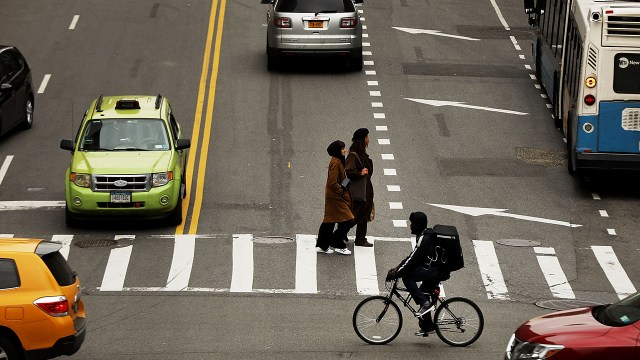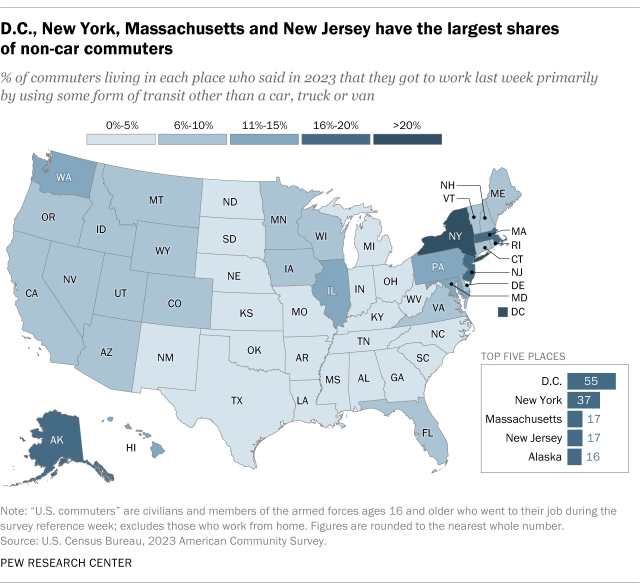
Driving is deeply ingrained in American culture. Most U.S. households have access to a car, and the vast majority of adults say they drive at least a few times a month.
Still, 10% of U.S. adults are nondrivers – that is, they say they seldom or never drive a car or other vehicle – according to a new Pew Research Center survey. This includes 6% who say they don’t drive at all.
Pew Research Center conducted this analysis to understand how many Americans are nondrivers (i.e., say they seldom or never personally drive) and how this group stands out from other adults. For this analysis, we used findings from a recent Center survey as well as data from the U.S. Census Bureau’s 2023 American Community Survey (ACS) 1-year estimates. Read more about the ACS’s methodology.
In this analysis, “households” include only homes and rental units that are occupied. Individuals living in group quarters are excluded. “Workers” are civilians and members of the armed forces ages 16 and older who went to their job during the survey reference week.
Survey findings draw from a poll of 5,410 U.S. adults conducted from Aug. 12 to 18, 2024. Everyone who took part in this survey is a member of the Center’s American Trends Panel (ATP), a group of people recruited through national, random sampling of residential addresses who have agreed to take surveys regularly. This kind of recruitment gives nearly all U.S. adults a chance of selection. Surveys were conducted either online or by telephone with a live interviewer. The survey is weighted to be representative of the U.S. adult population by gender, race, ethnicity, partisan affiliation, education and other factors. Read more about the ATP’s methodology.

Where people live plays a role in whether they drive. About two-in-ten adults living in urban areas (18%) say they seldom or never drive. That’s about double the shares of those who say this and live in suburban (7%) or rural areas (8%).
Those who live in the Northeast (17%) are more likely than those in the South (10%), West (8%) and Midwest (7%) to be nondrivers.
Beyond these geographic differences, certain groups of Americans are especially likely to say they seldom or never drive a car:
- Adults in lower-income households: 19% of those living in lower-income households seldom or never drive, compared with 6% of those in middle-income households and 3% of those in upper-income households.
- Black Americans: 21% of Black adults are nondrivers, compared with smaller shares of Asian (13%), Hispanic (12%) and White (7%) adults.
- Younger Americans: Adults under 30 (15%) are more likely than those ages 30 to 49 (9%), 50 to 64 (7%) and 65 and older (11%) to be nondrivers.
How Americans get to work
We were also interested in how a large subset of Americans get around – namely, workers. The U.S. Census Bureau offers a window into this group by asking about the main form of transportation they typically use to get to work.

Overall, 78% of workers ages 16 and older said they usually drove to their job in a car, truck or van during the previous week, according to the Census Bureau’s estimates from its 2023 American Community Survey (ACS). Looking at just auto commuters, the vast majority (88%) drove alone rather than carpooling.
Relatively few workers primarily got to work other ways: 4% took public transportation, 2% walked and fewer than 1% bicycled to work. Another 14% worked from home the previous week and did not commute. Fewer than 2% used another form of transportation (including taxis and motorcycles, among other methods).
However, there are some local differences in how people get to work.
In the District of Columbia and New York state, for instance, relatively small shares of working residents ages 16 and older drove to their job (33% and 55%, respectively). These were also the places with the highest shares of workers taking public transit: 22% of workers living in D.C. and 24% in New York state. One-in-ten New Jersey workers took public transit, the third-highest share in the country.

In places where a large percentage of workers do their jobs remotely, the share of car commuters increases when remote workers are factored out. In D.C., for example, 28% of workers did their job from home in the week before respondents took the 2023 survey. When looking at commuters only, 45% there primarily drove to work.
Other Pew Research Center studies on driving in the U.S.
The low share of drivers in New York was largely due to trends among workers living in New York City, which contains 42% of the state’s working population ages 16 and older. Just a quarter of New York City workers drove to their jobs in 2023, compared with 77% of New Yorkers outside the city. City residents were much more likely to take some form of public transit to work (48%) than to drive.
This is in line with previous research that found the majority of U.S. public transit commuters live in the country’s largest metro areas, while those in less populous areas overwhelmingly drive to work.
Most U.S. households have a car available
Even Americans who don’t commute by car may have one at home. Most U.S. households (92%) have at least one vehicle available for personal use, according to ACS estimates from 2023.
Nationally, 8% of households don’t have a vehicle, a third have one car available and 36% have two cars. Another 22% of households have three or more vehicles.
D.C. (36%), New York state (30%), Massachusetts (12%) and New Jersey (11%) are among the places with the highest shares of households with no vehicle available.
In rural, lower-density states like Idaho, Utah, New Hampshire and Montana, fewer than 5% of households go without a car. In three of these places, about a third of households have access to at least three vehicles, among the largest shares in any state.
In every state or jurisdiction but D.C. and New York state, about nine-in-ten or more households have at least one vehicle available.

